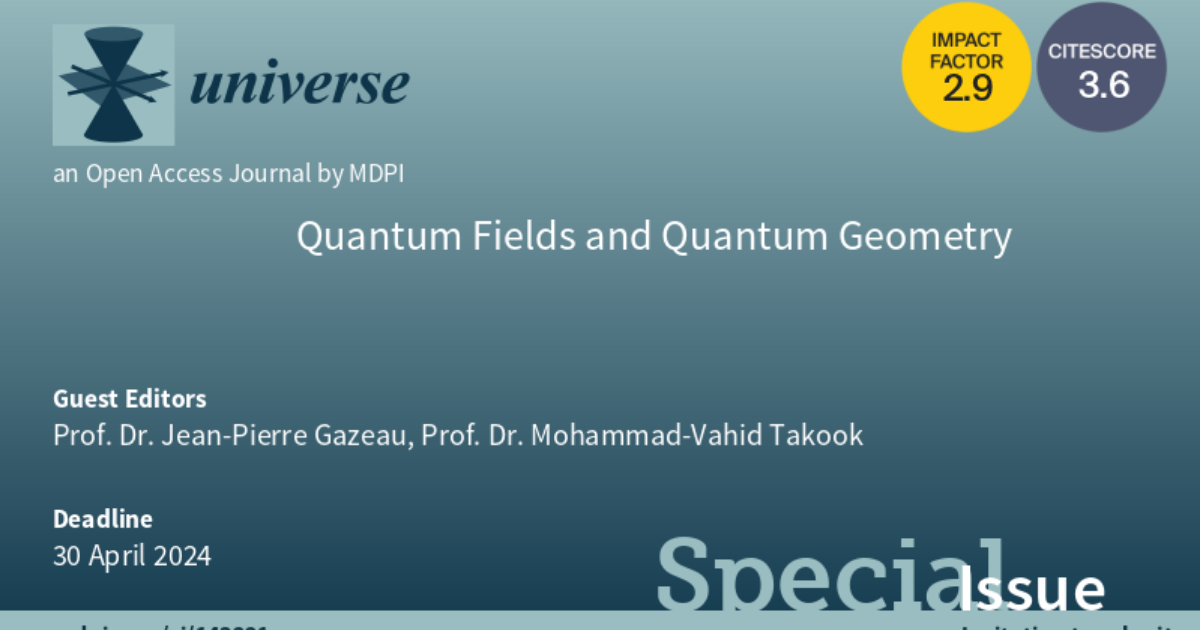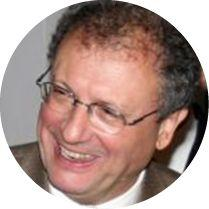Quantum Fields and Quantum Geometry
A special issue of Universe (ISSN 2218-1997). This special issue belongs to the section "Field Theory".
Deadline for manuscript submissions: 30 April 2024 | Viewed by 2487

Special Issue Editors
Interests: number theory and numeration systems for aperiodic order (diffraction patterns, construction of adapted wavelets); (covariant) integral quantization, specially with coherent states, of various classical systems; covariant integral quantization of cosmological models; quantum field theory in de sitter and anti-de sitter space-times, and cosmological implications (dark matter); deformation of standard probability distributions and related entropies; foundations of quantum physics
Special Issues, Collections and Topics in MDPI journals
2. Departement of Physics, Kharazmi University, 15719-1491 Tehran, Iran
Interests: de Sitter space; quantum field theory in a curved space-time; quantum gravity; quantum geometry; quantum technology
Special Issue Information
Dear Colleagues,
The Special Issue aims to collect contributions on all aspects of quantum field theory in curved space, from de Sitter and Anti-de-Sitter space–times to the most recent advances in quantum geometry, or the theory of operator field algebras.
There are already many books, e.g., Birrell and Davis (1982), Wald (1994) and (2018), Fulling (1989), Kay (1988), Ford (2002), Parker and Toms (2009), Bär and Fredenhagen (2009), etc.), reviews, e.g., the seminal BS DeWitt (1975), and uncountable articles on the subject, e.g., the recent arXiv:2206.10780v1, arXiv:2202.03357, etc. Nevertheless, these topics are rapidly evolving, and this Special Issue gives all researchers in this promising domain the opportunity to contribute in the form of a review or a specialised article.
All available models that point to quantum gravity start from the principles of quantum field theory and general relativity. However, one cannot obtain complete consistency between them. In this regard, quantum field theory in curved space–time needs to be studied in depth. We need a precise understanding of the Hilbert space construction, field operator algebra, the renormalisability problem, and the quantum state evolution. Quantum field theory in de Sitter and Anti-de Sitter spaces are the best examples for this purpose. Quantum de Sitter geometry represents the best model for the consideration of quantum geometry. The quantum state of geometry and its evolution are the challenging concepts of quantum geometry. The evolution of the quantum state may be given in terms of the total entropy of the universe. The de Sitter geometry quantum state evolution must be introduced with an observer-independent perspective. For this purpose, the relative entropy or von Neumann entropy must be used, which is defined in terms of in eigenstates in the appropriate Hilbert space.
We invite submissions of both original papers and review articles to this Special Issue, which places particular emphasis on ideas and framework problems based on quantum field theory in curved spacetime and quantum geometry. We believe that such frameworks have the potential to explain the quantum state of the universe in an observer-independent way. We are interested in collecting contributions focusing on a broad range of approaches and ideas, which emphasize quantum gravity and geometry and related issues, such as the question of evolution of quantum states in quantum gravity.
Prof. Dr. Jean-Pierre Gazeau
Prof. Dr. Mohammad-Vahid Takook
Guest Editors
Manuscript Submission Information
Manuscripts should be submitted online at www.mdpi.com by registering and logging in to this website. Once you are registered, click here to go to the submission form. Manuscripts can be submitted until the deadline. All submissions that pass pre-check are peer-reviewed. Accepted papers will be published continuously in the journal (as soon as accepted) and will be listed together on the special issue website. Research articles, review articles as well as short communications are invited. For planned papers, a title and short abstract (about 100 words) can be sent to the Editorial Office for announcement on this website.
Submitted manuscripts should not have been published previously, nor be under consideration for publication elsewhere (except conference proceedings papers). All manuscripts are thoroughly refereed through a single-blind peer-review process. A guide for authors and other relevant information for submission of manuscripts is available on the Instructions for Authors page. Universe is an international peer-reviewed open access monthly journal published by MDPI.
Please visit the Instructions for Authors page before submitting a manuscript. Submitted papers should be well formatted and use good English. Authors may use MDPI's English editing service prior to publication or during author revisions.
Keywords
- quantum geometry
- quantum field theory in curved spacetime
- quantum gravity






